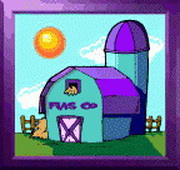Horns, Horn Information and How to disbud (dehorn) kids
First off, let me start by saying, you do not want a goat with horns. It is your decision to make, of course, but I'm talking to you now as a friend, let me say that, from personal experience, and knowing human nature, goats and goat behavior very well, please, do not get a goat with horns or you may regret it later. If your goats have kids, please be responsible and disbud them at the proper time. Yes, horns can be very beautiful, but they are also very dangerous, to you, your family and other goats. Even if the goat is a pet, and friendly, he/she can accidentally, or on purpose, seriously injure other goats, animals and humans. Goats learn to use their horns; they can, and will, use them on their herd mates (goats can, at times, be very violent with each other: it is their natural way). I know of a goat that gored her herd mate, while they were playing, through the chest, missing her heart by 1/2 inch. A loving pet goat with horns could easily, even if accentually, injure a child- it's just not worth the risk to your children. I hate to see a pet goat end up in the auction barn because they hurt their owner, their owners children, or their fellow herd mate.
Horns can, and do, get caught in fences, which can be very dangerous for the goat, causing her to strangle him or herself, or leaving him/her open to attack by predators. I knew a goat that got their horns caught is a low basketball net for an entire night. Don't think that if your goat has horns, he can/will defend himself against dogs (no matter what someone told you). If a dog wants to kill a goat, and he can get through your fence, he will kill the goat, with or without horns.
If you are going to show your goat, or the goat is a 4-H project, he/she must be disbudded.
Disbudding (removing the horn buds) is my least favorite part of goat keeping; I hate it more than I can tell you, but it has to be done. Sometimes we all have to do things that are not pleasant; this is part of the responsibility we take on when we get decide to care for our animals. Disbudding it has to be done at the right time or scurs can result. My philosophy with all things goats is that each individual is different, and you must take this into consideration.
I am a strong advocates of animal rights and ethical treatment. There are those who argue that disbudding is inhumane, that is their right: everyone is entitled to their own opinions. Though, it is easy to judge this issue on the simple fact it 'sounds' inhumane, but I live this issue and have first hand experience, so I am well equipped to be able to see the various sides of this particular situation. I have personally struggled with this issue and after considering and weighing all the options, I have come to the conclusion that it is in the goat's best interest to disbud them. In the long term, they will have not only safer lives (less likely to injure others) but they will also make better herd mates, and safer pets and companions, thus helping to guarantee they can live out their lives in good, loving, caring, permanent homes. Even if the goat is a pet, and friendly, he/she can accidentally, or on purpose, seriously injure other goats, animals and humans. I can cite many examples of this happening, to humans as well as other animals. Goats with horns can end up in the auction/sale barn because they injured their herd mate, owner or owner's family, and could end up living out less then ideal lives, or even being slaughtered. It's certainly better to go through a one time, 10 second, painful experience, then for a herd animal to be penned, or tied out alone, by themselves for the rest of their life, or worse yet, dead. I certainly don't disbud my kids because I enjoy it; I hate disbudding. I do it because it is in the best interest of the goat and is the responsible thing to do as the goat's caretaker. Sometimes life is not all simple & easy/ Black & White. We all go through difficult and painful experiences in our lives- that is the nature of life. It is my intent for my kids, that going through one short difficult experience when they are very young will alleviate more painful and difficult experiences later in life. When done correctly, with or without anesthesia, the goat suffers no long term negative physical or emotional effects from the procedure. Even though it seems certain they should "hold it against you", they never do, and I am speaking for many years of experience.
You may be interested to read my "Humane-ifesto"
Can you have the procedure done by a vet under anesthesia? Sure you can, but keep in mind that it is extremely hard to find a vet who actually knows anything about goats. Very importantly, you do not want your goats to get scurs (not to mention brain damage). I knew a person (we used to disbud her goats for) who decided to take all her kids to the University of Tennessee Vet Teaching School to have them disdudded. They all ended up with scurs, year after year. Scurs can cause problems and pain throughout the goat's life. Having your goats disbudded by a vet under anesthesia is also cost prohibitive for many people. If you feel the procedure as described below is inhumane (without anesthesia: note I do use a pain killer) then search out a vet who knows about goats and pay them to disbud your kids for you.
To judge when it is time to disbud, each kid gets his/her head felt every day after he/she is born. The day I feel a good "nub" is the day they get disbudded (it will feel like a hard pimple). This usually means on day 3 for boys and day 4-8 for girls (LaManchas). Every goat and breed is different on how quickly they grow their horns. I have had to disbud some boys on the second day, but even if they have a nub on the first, I will not disbud the first day (I feel the kid just isn't strong enough yet). If need be, I will wait longer, but the trick is to get it as early as possible. This way there is less of a chance of scurs. I have a rule here.... I never redisbud (I feel it is too cruel)... so I make sure to get it right the first time.
What are scurs?
Scurs are a partial horn growth. They are not full horns, but some of the horn bud was left, and this grows some horn. The scur is usually "loose" (but no always); not as solidly attached as a "real" horn. Scurs can range from being quite small, to being quite long. They may curl around like a wood shaving or grow straight out. All scurs are different just like all goats are different. Some can be "worse" than others. Some grow a lot, some just a little. Some are thin and some are thick. Some break off on occasion, some do not. Some need to be trimmed, some do not.
Bucks very often get scurs because they have so much testosterone that even if you are sure you got a good solid copper ring early enough, they manage to grow some horn (a scur). These buck scurs can get really bad, and you have to watch that they don't curl around and grow into the goat's scull. It this case, the scurs must be trimmed.
Trimming scurs: (I use a "wire saw" , also called an "OB saw", "Gigli saw" or Bone cutting saw ). You really only need to trim scurs if they start to curl around and start to grow into the goat's head. The reason you trim them is so they do not cause damage to the goat. Trim no more than one inch at a time, or you risk cause a lot of bleeding. Put the goat up in your milk stand (click here for free plans to build your own) to make this task doable, because they do not like it at all.
Scur trimming photos & description Photo Album - a must see
When bucks fight, they sometimes break off their scurs and may bleed profusely. In this case, clean the buck off as best you can and keep in mind that it looks much worst than it is.
What about using that disbudding paste?
Do not use it. It is extremely dangerous, for the animal as well as you, and it doesn't work very well. It very slowly burns off the bud and I feel is extremely inhumane to use.
What if my goat didn't get disbudded and now needs it's horns removed?
You cannot just cut off a goat's horns. The horns have large blood vessels running up them, and because of this, if you cut more than 1/2"- 1", or so, off the of horn, there will be a lot of bleeding.
Dehorning a goat is a horrible, bloody operation. Why? Because the goat's horns are actually a part of their skull; to remove the horns, you must remove part of the skull. By doing this, you open up a hole is the sinus cavity which will have to be cleaned and tended as the goat heals, or you risk possible infection. The operation must be done under anesthesia, by a vet who knows what he is doing. Be prepared for a lot of blood.
I have heard from some people who had this operation done on their goats. They said they would never put another goat through it again, and if they had it to do over again, knowing what they learned from the experience, they would not have done it.
What about using bands to remove horns? I have had a few people email me asking about using this technique to remove horns. I do not have any personal experience with this method and know of no one personally who has successfully used this method. There is another web site out that shows how to remove horns with bands, but I do not know how successful it is over the LONG TERM. Also, considering the goats have nerves and blood vessels in their horns, which are quite sensitive, and this procedure takes a long time to complete, I personally do not believe this method is humane (my own personal opinion). But, I also have heard/read no information on regarding how humane it is for the animal, so I suppose it is up to each individual person to decide for themselves how humane it is for their own animal. My feeling is, at least with disbudding, it is bloodless, is over very quickly, and we can give the kids a pain reliever to help them through the procedure.
How many kids can you disbud at one time (in a day)?
I have disbudded many, many kids and never had a health problem caused by the disbudding. Because I disbud when the kid needs it, and not when it is most convenient for me, I usually end up doing one a day, maybe two, and in some rare instances three in one day. Many breeders "save up" their kids and disbud them all at the same time. This is more convenient for the human, yes, but actually is very dangerous for the kids. The kids really should be done on the day they need it, and you should not do a lot of kids in a row for one very good reason-- it can cause brain damage to the kids. When you do a lot of kids at one time (let's say 6) the iron doesn't get to "warm up" properly for each kid, and so, may not be up to the proper temperature for the kids that are "last in line". Because the iron is not as hot, you have to hold it on the kid longer to get the proper orange ring. But, in doing this, you are heating up the brain of the kid more than it should be. This causes the brain to swell. The kid may not start showing signs of illness until over three weeks after the disbudding (usually at 3 1/2 weeks). The kid shows signs of what appears to be listeria, but when treated for listeria, the kid does not improve and usually dies. What has happened is that the brain has swollen due to being overheated during the disbudding, and cannot expand anymore due to being confined in the skull. The pressure on the brain starts to cause brain damage. The kid will die unless treated with anti-inflammatories. If treated fast enough, the kid may be saved, but will never be totally "right" in the head. The best way to avoid this problem is to let your disbudding iron heat up at least 10 minutes between each kid and not do more than 4 in a day.
See below for more disbudding Questions & Answers, hints and comments.
How to disbud a goat kid:
Also see: Disbudding photos & description Photo Album - a must see
Supplies:
1. Disbudding iron with a fireproof holder.
2. Steel wool to clean tip of iron.
3. Board to test iron.
4. Kid holding
box.
You can build your own. Caprine Supply, sells an aluminum headpiece for a kidding box. When
you purchase this, they also supply instruction on building
the box.
5. Towel to adjust floor level of box to the size of kid.
6. Clippers - I use Oster human hair trimmers; they work quite well. You can also use cordless beard trimmers.
30 minutes before disbudding I always give the kid Owe-Eze Herbal Tincture (2 ml).
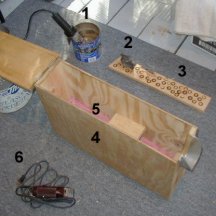
The disbudding iron is no place to try to save money. Get a good quality one that will do the job quickly. A low quality iron heats slower and may not get hot enough, thus making the procedure take longer and cause undue stress and pain to the kid.
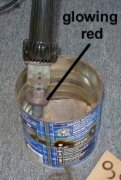
NOTE: I used the Rhinehart X-50 Disbudding Iron with the proper goat tip for 10 years, but after going through our second one (it stopped working in after just one year), I decided to give the X-30 a try. The Rhinehart X-30 rocks and rolls! It has the proper sized tip built in as opposed to added on like the X-50, and so it heats up hotter and the actual tip gets glowing red, unlike the X-50. I found it took almost half the time (less applications and shorter applications) to disbud using the X-30 than when using the X-50. Be aware of this when using these instruction, which were origianlly written using the X-50. I like the X-30 much better than the X-50 because it is quicker and thus causes less stress for everyone involved.
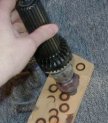 Let
the disbudding iron heat up until it is glowing red (at least
10 minutes; I let it warm up at least 15 minutes)
Let
the disbudding iron heat up until it is glowing red (at least
10 minutes; I let it warm up at least 15 minutes)
When you apply the iron to a wooden board, you get an immediate dark brown ring and smoke.
To disbud, I put the kid in a disbudding box. I put towels in the bottom of the box as needed to adjust for the size of the kid. The towels raise the level of the box floor as needed for smaller kids. You don't want the kid choking himself because his feet don't reach the floor.
The disbudder sits on the box, The holder (usually me) sits on the ground in front of the box, facing the kid. I hold the head and the disbudder shaves the "nub area". We find the "nub" by feel.
Most of the time, the kid will scream just as much about having his head shaved as getting his head burnt. They just do not like being restrained.
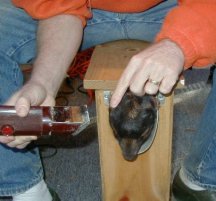
You must do a thorough shaving job, or you will get so much smoke from the burning hair, you will not be able to see what you are doing.
I use regular human hair clippers to trim our goats' hair. They cost about $12-$20, which is much cheaper than $100 for "real" clippers intended for animal use (like the ones in the photos) yet they work just as well. My "real" clippers died and I just use human hair trimmers now for my goats. For this application, you could even use a beard trimmer for even more exact trimming.
Here is a photo after the kid's haircut. Note that you can now see his "nub".
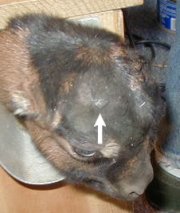
I, wearing thick gloves, hold the kid's head tightly against the head piece. (I usually use both hands to hold the kid, but am having to hold the kid and take the picture for this photo.) The kids can be incredibly strong and you need to hold the head as still as possible.
The disbudder applies the iron. The open circle of the tip of the iron going over the shaved "nub" on the kid's head. The bud goes right, dead center, in the middle of the hole in the iron tip and may not get touched by the iron (depending on it's size) The pressure of the iron is rotated (putting even pressure at 1 o'clock and slowly moving the even pressure to 2 o'clock, 3 o'clock, etc.). The amount of pressure applied is pretty much just that of the weight of the iron. Each "go-'round" application with the X-50 takes only a about 4-5 seconds. WIth the X-30, the first application is about 3-4 seconds and the second about 5 seconds.
I blow on the kids head during the application of the iron to remove the smoke so the disbudder can see.
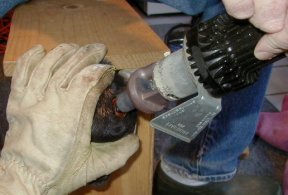
The disbudder removes the iron and as I blow on the kid's head to cool it and reassure him, we look at the burn.
You are shooting for a nice solid copper ring. If you don't have the copper ring on the first go-'round (which you rarely ever do) you give it another go. Apply the red hot iron again and rotate the pressure.
Note: When using the X-50 I'd do two applications then move to the other side to let the first side cool. WIth the X-30 I do one application and move to the next side.
Stop, look for the copper ring, repeat if necessary. At this point you may have a copper ring around most of the nub, but not completely. In this case, just apply the iron where needed to complete the ring.
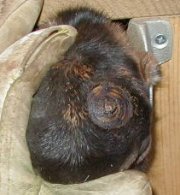 This photo
shows the "burn"
This photo
shows the "burn"
after the "first go-round".
The stopping to look at the kids head as you disbud serves a few purposes. First, you can see exactly how much burning you must do for each kid (every kid is different). You don't under do it, you don't over do it.
Also, the stopping to check the ring allows the kid's head to cool off a bit, so that you don't worry as much about "frying his brain".
If the kid seems to be "taking it hard", take a break and let him recover. This is not a race.
After two applications with the X-50 and one with the X-30, I will go on to the other side and let the first side cool off a little bit before coming back to complete the job.

How many total applications you will need to make to each horn bud depends on your disbudding iron and the temperature of where you are disbudding. You just need to be aware that every situation is different and you need to use your common sense and work toward getting that copper ring. With the X-50 sometimes we got the complete ring in three goes and sometimes it took up to 5 (what a nightmare). With the X-30 it tends to take just 2-3 applications, usually 2 when the weather is not too cold.
Be aware that if you are working in cold weather, the iron will have to work harder to stay up to temperature, so it may take more applications.
Once you have the complete copper ring, take the edge of the iron tip and carefully burn/nudge the center, where the nub is. You are not trying to get the copper color here, you are just burning enough to a be able to "scrape" off the top of the nub (the skin covering the nub).
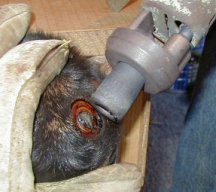
Once you are done with this horrible job, do not apply anything to the burns. They are cauterized and "clean" wounds. Return the kid right a way to his mom, or give him a bottle if he is being bottle raised. He will be fine and will not hold the incident against you.
I wait at least 10 minutes between kids so that the iron gets good and glowing red hot for the next kid. This really makes a difference in how easily and quickly the disbudding goes.
The day after disbudding, I apply Molly's Marvelous Herbal Salve to the area the was burnt. Do not apply the salve until the next day.
In a few days, the burnt area will become a scab. In about 3 to 5 weeks (depending on the kid) the scabs will fall off on their own. Do not pick at them. When the scabs do fall off, the area may bleed so we always apply Molly's Marvelous Herbal Salve at this time (we feel it helps with the healing). Note that the scabs do not necessarily fall off a the same time, it may take days or even weeks before the second scab falls off.
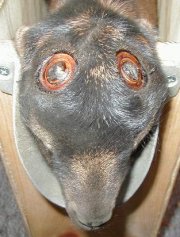
You now have a hornless goat.
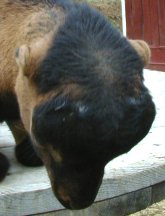
This photo was taken 7 weeks later, when the kid was 2 months old. The scabs have fallen off and the hair has almost completely grown back. There are just two very small "bald" spots, that will soon be covered with hair as well.
Hint from Molly: Be calm and take you time. Rushing the job will only cause problems with improper disbudding
Q: "One of Nellie's scab fall one and the other has not should I worry?"
A: The scabs will fall off when they are ready. They do not fall off a the same time, and your Nellie is doing fine and normally. Be patient.
Comment from "gb": Something about disbudding. It makes me nervous. I just did my second kid last Sunday. Not nearly as traumatic as with Nellie (for me! Never mind the kid.) But I still wasn't sure that the job was done properly.
My secretary helped me hold the kid. She shut her eyes through most of it. But she said I took my time and was quite thorough. I just couldn't believe it could be that simple! Helps a lot if you have an idea about what you are doing.
As to the scab. My secretary found the first one that fell of Nellie. I took a good look at it. I was surprised to see that it looks like a little hat. The raised bit in the center is just the heart of it. Now I see why we go for the copper ring. We are burning the rim of the hat - not the kid's skull directly. You might care to explain that on your web page. I think novices might feel a lot easier about disbudding if they know that the copper ring is actually obtained on part of the horn bud, which is the shape of a hat.
May it get easier and easier - for me and the kids!
